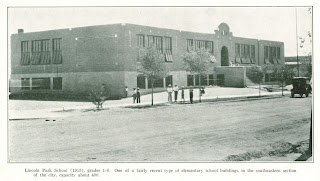 |
| (El Paso Public Library, El Paso Schools) |
Lincoln Center: Life, Death, Rebirth, and Death Row
Share
By Raymundo Eli Rojas
Growing up in El Paso, if you are paying attention at least, it will come as no surprise that South Central El Paso has poverty. At least that was the perception that I had, a kind of naive notion of poverty.
It wasn't until I read the two reports by the City of El Paso about the Chamizal Neighborhood in South Central El Paso that I found how bad things have gotten. I wrote about this in an earlier post, Are the Problems of El Paso's Chamizal Neighborhood El Paso City Gov't's Own Creation?. Don't get me wrong, I seldom blame poverty on the people themselves (and I'm not doing it here) as there are other forces at work to keep people in poverty as my article shows.
For the last year, much of my community work has focused on trying to bring the youth of this area, alternatives to crime, drug use, teenage pregnancy. The work has not been directly with youth as I'm probably the worst at interacting with them. However, not only have juveniles been my cause, but also the elderly poor.
City Parks and Recreation Departments play a huge role in many of the issues mentioned above, but not only those. More parks and recreation services help to curve obesity, diabetes, and other health maladies. So it is not surprising we claim environmental racism when there is a lack of parks and community centers in neighborhoods.
Lincoln Center lies in the old Eastside of El Paso. At one time Raynolds Street was the El Paso city limit. Moreover, these neighborhoods of Chamizal, Durzano, and Lincoln Park share a common victimhood of urban renewal. Interstate 10, Highway 54, Paisano Drive, the Port-of-Entry have all contributed to the economic-ethnic isolation that these neighborhoods experienced.
When one views Lincoln Center today, it sits under the I-10-Hwy 54 Interchange, the so-called Spaghetti Bowl. However, at one time the Lincoln Park neighborhood extended north beyond what is now I-10.
The Lincoln Park Addition was filed in 1909 and the building of the school came later in 1915, though some city publications say 1912, the year the Titanic sunk, the year my grandfather was born. In the late 1940s, the El Valle Addition was added just east of Lincoln and it extended over what is now I-10. Reflecting the war that had just been fought in Europe and the Pacific, the El Valle Addition bore street names like Bataan and Saipan.
The 1950s would bring the interstate system to El Paso. Long enamored by the German Autobahn, President Eisenhower wanted to bring such a system to the United States and in the late 1950s, Interstate 10 came into El Paso from the north and from the east. The northern part of the Lincoln Park neighborhood was demolished to make room for I-10, including many houses and Calvario Catholic Church. I-10 also divided the El Valle Addition.
It was here that something funny happened. The part of I-10 that was built from Raynolds to the present Spaghetti bowl, included a water outlet. Knowing full well, the El Valle Addition (now known as Saipan) was right below the water outlet, the outlet was still built right above the neighborhood. This would come to haunt the Lincoln neighborhood for many years resulting in flooding.
 |
| Water Outlet that Flooded the Saipan Neighborhood of Lincoln Park |
Another victim of the building of the I-10-Hwy 54 Interchange was Lincoln School. By 1970s, connecting Hwy 54 to the border was the plan and Lincoln School did not fit into this plan. The school was in the right-of-way and the school closed in 1970 and the property was turned over to the state. It was used as a base by the Texas Department of Transportation and later closed.
 |
| (Texas Highways, June 1970) |
However, Lincoln resident were not satisfied. They organized themselves and got the city to lease the building and make Lincoln School a community center, so by the late 1970s, it was a full-fledged center.
Rosa Guerrero started her first ballet folklorico classes at Lincoln Center. Parks and Recreation would have offices there as well as LULAC and Project Bravo. From Lincoln's halls, many Fiesta de Las Flores festival were planned, Project Amistad was born, day care was supplied to the surrounding neighborhoods, the Gus and Goldie franchise was created, Midnight Basketball was organized, food distribution would take place.
 |
| Calvario Catholic Church, founded in 1933 at 4000 Durazno awaiting demolition |
After Calvario's destruction, mass was held outside in Lincoln Park. Later Lincoln Center would lend itself for masses so people would not have to attend mass in the cold or heat. It would not give Lincoln Center justice saying Lincoln Center served only Lincoln. It was a community center for all the surrounding barrios. One friend of mine who lived in the apartments at the old Mitchell Brewery building says she took her first ballet classes there. Another friend said she played basketball with a city league out of Lincoln Center. The memories can go on and on.
Lincoln had become the center of the community.